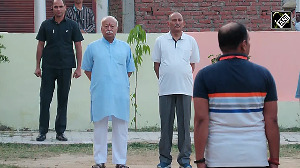 The clamour for rate cuts became louder after January's headline inflation stood at 6.5 per cent.
The clamour for rate cuts became louder after January's headline inflation stood at 6.5 per cent.
However, what makes January's print more relevant is for the first time in 12 months, 'core' inflation, or non-food manufactured inflation, has fallen below the seven per cent level. So far, the fall in inflation has been driven by lower food prices.
But now, even core inflation seems to be easing.
But it's too early to rejoice.
As Leif Eskesen, Asean economist at HSBC, explains, a big part of the steep decline in headline inflation in January can be explained by the high base last year, when excess rains destroyed crops and led to a spike in food prices. Improved food supplies in 2011 have also helped contain food inflation.
It's easy to argue that the softness in core inflation is an obvious trigger for a rate cut. Coupled with this, the rupee has recouped some of its losses against the dollar, which would also have a positive impact on inflation.
The market believes the stage is set for a rate cut, sooner than later. But should the Reserve Bank of India reverse the rate cycle just yet?
Economists believe though rate cuts are imminent, the quantum and the timing are not a given yet, as upside risks to inflation still remain. For starters, prices have come off, primarily due to slowing growth. Slowing growth by depressing demand was the only option the central bank had to deal with price rise.
For starters, prices have come off, primarily due to slowing growth. Slowing growth by depressing demand was the only option the central bank had to deal with price rise.
So, it's unlikely that the central bank will reverse this in a hurry, given supply side issues have not yet been addressed by the government.
Indranil Pan, chief economist at Kotak Mahindra Bank, says while 6.9 per cent growth in gross domestic product does seem low compared with the nine per cent levels the economy saw in the past, the full employment rate of growth is 7.5 per cent.
Full rate of employment growth is the cut-off rate of growth at which the economy functions at optimum capacity.
Price pressures emerge when an economy grows faster than the full employment rate of growth, or its optimum capacity.
What this implies is the depression in economic growth is planned.
However, if growth remains at seven per cent levels, RBI would extend the period of pause.
But if GDP growth for the third quarter FY12 is close to six per cent, the central bank would be under immense pressure to cut rates.
However, economists believe in case the rate cuts start by April, the threshold levels of inflation could soon be breached again.
According to Siddhartha Sanyal, chief economist at Barclays Capital, issues such as the possibility of fresh liquidity injections and the potential upward pressure on global commodity prices are likely to keep the central bank wary.
Says Sanyal: "We believe the third-quarter GDP figure later this month would be critical to RBI's final decision for the March policy.
"In case the GDP growth figure comes closer to six per cent levels, the pressure on the central bank to cut rates will increase substantially.
"At the current level of inflation, a rate cut is difficult. But as the policy rate is as high as 8.5 per cent, RBI has the headroom of at least 100 basis points through 2012-13, unless we face any further surprise on the inflation front."
RBI is dragging its feet on rate cuts as most of the downside in inflation is due to food prices coming off due to a high base effect.
If the purchasing managers' index has bounced back, core inflation will also rebound from the low levels in January, believe economists.
Therefore, RBI should not be as dynamic in rate cuts. Says Pan, "From April, we do see rate cuts. But our projection for the full year is 100 basis points."
In effect, what RBI can do is reverse the last set of rate increases.
The final decision to cut rates would be influenced by two key data points -- the third quarter GDP numbers and the inflation print for February.
For starters, the central bank does not have much policy space to deliver the aggressive rate cuts it affected in 2008-09. Eskesen sums it up rather well: "RBI is likely to first want to see credible promise of fiscal consolidation and notable progress on (or at least prospects of) supply-side reforms before rate cuts will be delivered.
"This takes us to the April-June quarter, and likely the April meet."











 © 2025
© 2025